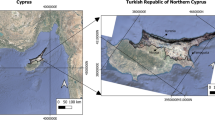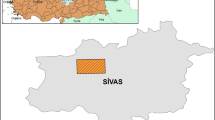Abstract
The integration of remote sensing, geographic information system, landscape ecology and statistical analysis methods was applied to study the urban thermal environment in Guangzhou. Normalized Difference Vegetation Index (NDVI), Normalized Difference Build-up Index (NDBI), Normalized Difference Barren Index (NDBaI) and Modified Normalized Difference Water Index (MNDWI) were used to analyze the relationships between land surface temperature (LST) and land use/land cover (LULC) qualitatively. The result revealed that, most urban built-up lands were located in the middle part, and high LST areas mostly and were in the middle and southern parts. Therefore, the urbanization and thermal environment in the middle and southern parts need to be determined. Land surface temperature increased with the density of urban built-up and barren land, but decreased with vegetation cover. The relationship between MNDWI and LST was found to be negative, which implied that pure water would decrease the surface temperature and the polluted water would increase the surface temperature. A multiple regression between LST and each indices as well as the elevation was created to elevate the urban thermal environment, which showed that NDVI, NDBI, NDBaI, MNDWI were effective indicators for quantifying LULC impacts on LST.





Similar content being viewed by others
References
Bourke P (1988) Calculating the area and centroid of a polygon. http://local.wasp.uwa.edu.au/~pbourke/geometry/polyarea/. Retrieved 26 March 2009
Carson TN, Gillies RR, Perry EM (1994) A method to make use of thermal infrared temperature and NDVI measurements to infer surface soil water content and fractional vegetation cover. Remote Sens Rev 9:161–173
Chen X, Zhao H, Li P, Yin Z (2006) Remote sensing image-based analysis of the relationship between urban heat island and land use/cover changes. Remote Sens Environ 104:133–146
Chander G, Markham B (2005) Revised Landsat 5 TM radiometric calibration procedures and post-calibration dynamic ranges. USGS, USA
Dousset B, Gourmelon F (2003) Satellite multi-sensor data analysis of urban surface temperatures and land cover. ISPRS J Photogramm 58:43–54
Gallo KP, Owen TW (1998) Satellite-based adjustments for the urban heat island temperature bias. J Appl Meteorol 38:806–813
Gillies RR, Carlson TN (1995) Thermal remote sensing of surface soil water content with partial vegetation cover for incorporation into climate models. J Appl Meteorol 34:745–756
Gillespie AR, Rokugawa S, Matsunaga T et al (1998) A temperature and emissivity separation algorithm for advanced spaceborne thermal emission and reflection radiometer (ASTER) images. IEEE T Geosci Remote 36(4):1113–1126
Goetz SJ (1997) Muti-sensor analysis of NDVI, surface temperature and biophysical variables at a mixed grassland site. Int J Remote Sens 18(1):71–94
Gong J, Liu Y, Xia B (2009) Spatial heterogeneity of urban land-cover landscape in Guangzhou from 1990 to 2005. J Geogr Sci 19:213–224
Jimenez-Munoz JC, Sobrino JA (2003) A generalized single-channel method for retrieving land surface temperature from remote sensing data. J Geophys Res 108(D22):4688–4695
Li H, Liu Q, Zou J (2009) Relationships of LST to NDBI and NDVI in Changsha-Zhuzhou-Xiangtan area based on MODIS data. Sci Geogr Sin 29(2):262–267
Liu H, Weng Q (2008) Seasonal variations in the relationship between landscape pattern and land surface temperature in Indianapolis, USA. Environ Monit Assess 144(1–3):199–219
Ortiz MJ, Formaggio AR, Epiphanio CN (1997) Classification of croplands through integration of remote sensing, GIS and historical database. Int J Remote Sens 18(1):95–105
Purevdorj TS, Tateishi R, Ishiyama T, Honda Y (1998) Relationships between percent vegetation cover and vegetation indices. Int J Remote Sens 19(18):3519–3535
Qin Z, Karnieli A, Berliner P (2001) A mono-window algorithm for retrieving land surface temperature from Landsat TM data and its application to the Israel–Egypt border region. Int J Remote Sens 22(18):3719–3746
Qin Z, Li W, Xu B et al (2004) The estimation of land surface emissivity for LANDSAT TM6. Remote Sens Land Resour 3:28–36 (in Chinese)
Rouse JW, Haas RH, Schell JA et al (1974) Monitoring the vernal advancement of retrogradation of natural vegetation. NASA/GSFC, type III, final report, Greenbelt
Streutker DR (2003) Satellite-measured growth of the urban heat island of Houston, Texas. Remote Sens Environ 85(3):282–289
Sobrino JA, Li ZL, Stoll MP et al (1996) Multi-channel and multi-angle algorithms for estimating sea and Land Surface Temperature with ATSR data. Int J Remote Sens 17(11):2089–2114
Sobrino JA, Jimenez-Munoz JC, Paolini L (2004) Land surface temperature retrieval from LANDSAT TM 5. Remote Sens Environ 90(4):434–440
Sun Q, Tan J, Xu Y (2010) An ERDAS image processing method for retrieving LST and describing urban heat evolution. Environ Earth Sci 59(5):1047–1055
Tobu NC, David AR (1997) On the relation between NDVI fractional vegetation cover, and leaf area index. Remote Sens Environ 62(3):241–252
Valor E, Caselles V (1996) Mapping land surface emissivity from NDVI: application to European, African and South American areas. Remote Sens Environ 57(3):167–184
Van de Griend AA, Owe M (1993) On the relationship between thermal emissivity and the normalized difference vegetation index for natural surfaces. Int J Remote Sens 14(6):1119–1131
Weng Q (2001) A remote sensing-GIS evaluation of urban expansion and its impact on surface temperature in the Zhujiang Delta, China. Int J Remote Sens 22(10):1999–2014
Weng Q (2003) Fractal analysis of satellite-detected urban heat island effect. Photogramm Eng Remote Sens 69:555–566
Weng Q, Lu D, Schubring J (2004) Estimation of land surface temperature-vegetation abundance relationship for urban heat island studies. Remote Sens Environ 89(4):467–483
Xiao H, Weng Q (2007) The impact of land use and land cover changes on land surface temperature in a Karst area of China. J Environ Manage 85(1):245–257
Xu H (2005) A study on information extraction of water body with the modified normalized difference water index (MNDW I). J Remote Sens 9(5):589–595 (In Chinese)
Yuan F, Bauer ME (2007) Comparison of impervious surface area and normalized difference vegetation index as indicators of surface urban heat island effects in Landsat imagery. Remote Sens Environ 106(3):375–386
Zha Y, Gao J, Ni S (2003) Use of normalized difference built-up index in automatically mapping urban areas from TM imagery. Int J Remote Sens 24(3):583–594
Zhao H, Chen X (2005) Use of normalized difference bareness index in quickly mapping bare areas from TM/ETM+. Geosci Remote Sens Symp 3(25–29):1666–1668
Acknowledgments
The authors would like to express their sincere thanks to the reviewers for their constructive suggestions, comments and helps. This research is supported by the research fund of LREIS, CAS (Grant No. 2010KF0006SA).
Author information
Authors and Affiliations
Corresponding author
Rights and permissions
About this article
Cite this article
Sun, Q., Wu, Z. & Tan, J. The relationship between land surface temperature and land use/land cover in Guangzhou, China. Environ Earth Sci 65, 1687–1694 (2012). https://doi.org/10.1007/s12665-011-1145-2
Received:
Accepted:
Published:
Issue Date:
DOI: https://doi.org/10.1007/s12665-011-1145-2




